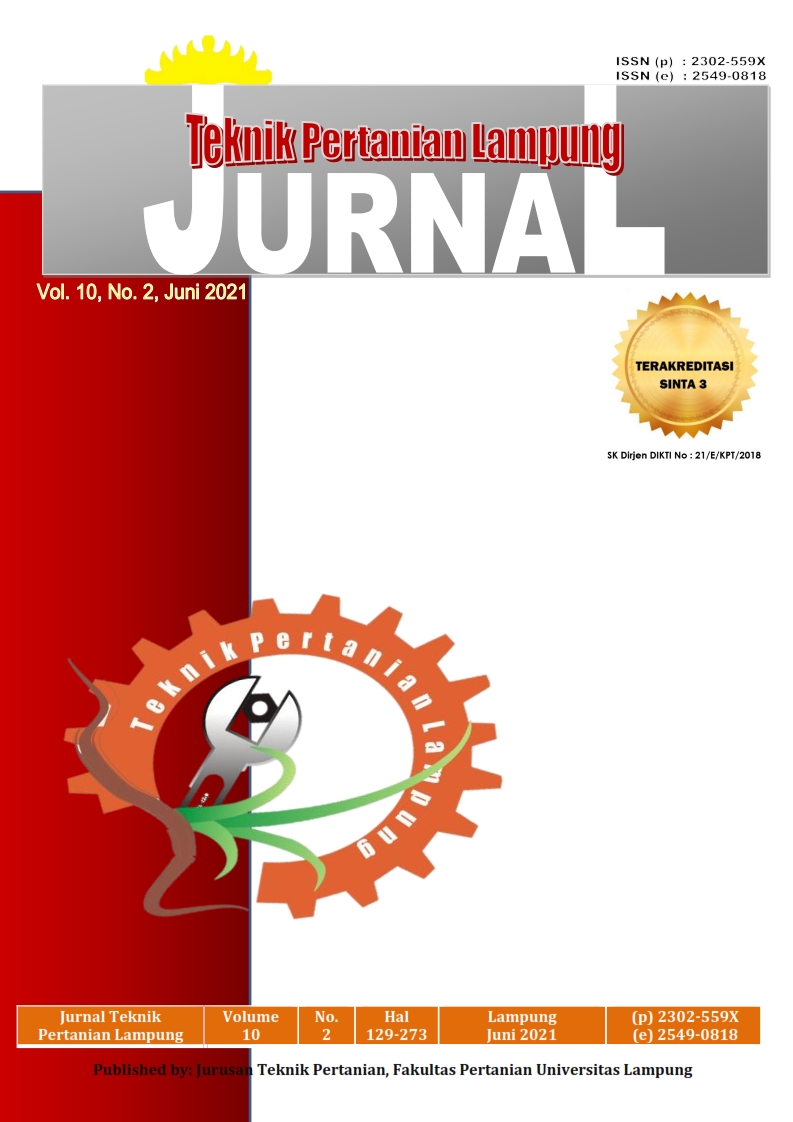UJI KINERJA DAN KELAYAKAN FINANSIAL PENGERING PATI SAGU TIPE PNEUMATIC CONVEYING RING DRYER
DOI:
https://doi.org/10.23960/jtep-l.v10i2.228-238Abstract
Sago starch drying in remote areas or difficult to reach transportation requires artificial dryers to increase the quantity and quality of the dry sago starch. The purpose of this study was to test performance, and analyze the economic value of biomass powered pneumatic conveying ring dryer (PCRD) for drying sago starch for small scale commercial. This research was conducted in two stages, namely performance testing and financial analysis. Small scale (mini) PCRD has been created for drying sago starch with a capacity of 160 kg of dry sago starch per day. The resulting moisture content varies according to variations in temperature and initial moisture content of sago starch and has met the Indonesia National Standard (SNI) No. 3729 regarding the maximum water content of sago starch (13%), except at temperature variations of 50oC and 75oC with an initial moisture content of 41% that did not meet the SNI, which was greater than 13% (14.27% and 13.23%). The drying efficiency varies between 7.339% to 9.689%. Likewise, the yield of dry sago starch that was produced varied between 65% and 73%. PCRD is very feasible to be developed into a commercial scale sago starch dryer with a Pay back value of 2.66 years to return the initial capital of Rp. 186,879,200.
Keywords: drying, financial analysis, PCRD, sago starch
References
Ajao, K., dan Adegun, I. 2019. Performance Evaluation of a Locally Fabricated Mini Cassava Flash Dryer. Journal Agricultural Technology, 5(2): 281–289.
Badan Standar Nasional. 2008. Tepung sagu: SNI 3729.
Brooker, D., Bakker-Arkema, F., dan Hall, C. 1992. Drying and Storage of Grains and Oilseeds. An avi Book Van Nostrand Reinhold.
Chapius, A., Precoppe, M., Meot, J., Sriroth, K., dan Tran, T. 2017. Pneumatic Drying of Cassava Starch: Numerical Analysis and Guidelines for the Design og Efficient Small-scale Dryers. Drying Technology An International Journal, 35(4): 393–408.
Husnan, S., dan Suwarsono. 1997. Studi Kelayakan Proyek (Kedua). UPP AMP YKPN.
Jading, A. 2018. Pengembangan Model Matematis dan Kecerdasan Buatan pada Perancangan Pneumatic Recirculation Conveying Dryer untuk Proses Pengeringan Pati Sagu. Universitas Gadjah Mada.
Jading, A., Bintoro, N., Sutiarso, L., dan Karyadi, J.N. 2018. Model Matematis Pengeringan Pati Sagu pada Pneumatic Conveying Recirculated Dryer. Agritech, 38(2): 217–226.
Jading, A., Bintoro, N., Sutiarso, L., dan Wahyu, J. N. 2016. Analisis Efisiensi Pneumatic Conveying Recirculated Dryer untuk Pengeringan Bahan-bahan Tepung. Seminar Nasional Fakultas Pertanian UPN Veteran, 370–378.
Jading, A., Payung, P., Aman, W., dan Tethool, E. 2012. Modifikasi Tungku Gasifikasi untuk Pemanfaatan Limbah Biomassa Sebagai Sumber Energi Alternatif Pada Proses Pengeringan Hasil Pertanian. Istech, 4(2): 1–8.
Jading, A., Payung, P., Aman, W., dan Tethool, E. 2014a. Pengembangan dan Analisis Teknis-Finansial Alat Pengering Pati Sagu Model Agro Cross Flow Fluidized untuk Menunjang Agroindustri Sagu di Papua. Jurnal Teknologi Industri Pertanian, 24(2): 137–147.
Jading, A., Payung, P., dan Reniana. 2014b. Kajian Teknis-Ekonomis Alat Pengering Pati Sagu Model Cross Flow Vibro Fluidized Bed. Agritech, 34(4): 448–455.
Jading, A., Tethool, E., dan Payung, P. 2019. Rancang Bangun Sistem Pengumpan Bahan pada Pneumatic Conveying Ring Dryer. Seminar Nasional Fakultas Teknik Universitas Wahid Hasyim.
Kusharjanto, B., Sundari, M., dan Himawanto, D. (2013). Rancang Bangun Prototipe Flash Dryer untuk Penegeringan Tepung Mocaf. Simposium Nasional RAPI XII, 74–78.
Kuye, A., Ayo, D., Sanni, L., Raji, A., Kwaya, E., Otuu, O., Asiru, W., Alenke, B., Abdulkareem, I., Bamkefa, B., Tarawali, G., Dixon, A. G., dan Okechukwu, R. 2011. Design and Fabrication of Flash Dryer for the Production of High Quality Cassava Flour. www.iita.org
Lydersen, A. 1978. Fluid Flow and Transfer. John Wiley dan Sons.
Nugroho, J., Primawati, dan Bintoro, N. 2012a. Pengeringan Umbi Kimpul (Xanthosoma sagittifolium Schott) Sawut dengan Pneumatic Dryer. Peran Keteknikan Pertanian Dalm Pembangunan Industri Pertanian Berkelanjutan Berbasis Kearifan Lokal.
Nugroho, J., Primawati, dan Bintoro, N. 2012b. Proses Pengeringan Singkong (Manihot esculenta crantz) Parut Dengan Menggunakan Pneumatic Dryer. Peran Keteknikan Pertanian Dalam Pembangunan Industri Pertanian Berkelanjutan Berbasis Kearifan Lokal, 105–112.
Paisal, E., Mahatta, F., dan Abimayu, B. 2018. Rancang Bangun Alat Pengering Tipe Tray Dryer. Agroteknika, 1(1): 31–38.
Prasnowo, M. dan Nurdin, S. 2019. Analisis Kelayakan Mesin Pengering Keripik Kentang. Agrointek, 13(1): 10–13.
Purbono, K., Ainuri, M., dan Suryandono. 2010. Rancang Bangun dan Uji Kelayakan Finansial Alat Pengering Mekanis untuk Pemenuhan Pasokan Eceng Gondok (Eichhornia crassipes) sebagai bahan baku kerajinan. Agritech, 30(2): 80–89.
Singh, R., dan Heldman, D. 2009. Introduction to Food Engineering (Fourth Edi). Academic Press ELSIVIER.
Suherman, Kuncoro, A. ., dan Kusworo, T. 2015. Eksperimental Study on Drying Kinetics of Cassava Starch in a Pneumatic Drying System. International Conference of Chemical and Material Engineering (ICCME) AIP Conference, 1–6.
Tanaka, F., Uchino, T., Hamanaka, D., dan Atungulu, G. 2008. Mathematical Modelling of Pneumatic Drying of Rice Powder. Journal of Food Engineering, 88: 492–498.
Witdarko, Y., Bintoro, N., Suratmo, B., dan Rahardjo, B. 2016. Pemodelan Matematis Hubungan Kadar Air Tepung dengan Variabel Proses pada Pengering Mekanis Tepung Casava Menggunakan Pneumatic Dryer. Agritech, 36(1): 111–116.
Downloads
Published
Issue
Section
License
- Authors who publish with this journal agree to the following terms:
- Authors retain copyright and grant the journal right of first publication with the work simultaneously licensed under a Creative Commons Attribution-ShareAlike 4.0 International Lice that allows others to share the work with an acknowledgement of the work's authorship and initial publication in this journal.
- Authors are able to enter into separate, additional contractual arrangements for the non-exclusive distribution of the journal's published version of the work (e.g., post it to an institutional repository or publish it in a book), with an acknowledgement of its initial publication in this journal.
- Authors are permitted and encouraged to post their work online (e.g., in institutional repositories or on their website) prior to and during the submission process, as it can lead to productive exchanges, as well as earlier and greater citation of published work (See The Effect of Open Access).
Jurnal Teknik Pertanian Lampung

JTEPL is licensed under a Creative Commons Attribution-ShareAlike 4.0 International License.

